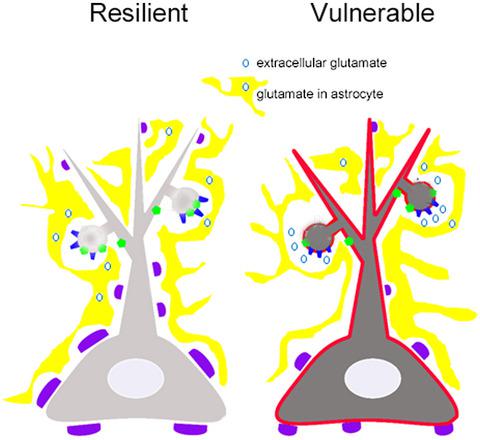Our official English website, www.x-mol.net, welcomes your feedback! (Note: you will need to create a separate account there.)
Suppression of food restriction‐evoked hyperactivity in activity‐based anorexia animal model through glutamate transporters GLT‐1 at excitatory synapses in the hippocampus
SYNAPSE ( IF 2.3 ) Pub Date : 2021-02-22 , DOI: 10.1002/syn.22197 Olesia M Bilash 1, 2 , Hannah S Actor-Engel 2 , Ang D Sherpa 2 , Yi-Wen Chen 2 , Chiye Aoki 1, 2
SYNAPSE ( IF 2.3 ) Pub Date : 2021-02-22 , DOI: 10.1002/syn.22197 Olesia M Bilash 1, 2 , Hannah S Actor-Engel 2 , Ang D Sherpa 2 , Yi-Wen Chen 2 , Chiye Aoki 1, 2
Affiliation

|
Severe voluntary food restriction is the defining symptom of anorexia nervosa (AN), but anxiety and excessive exercise are maladaptive symptoms that contribute significantly to the severity of AN and which individuals with AN have difficulty suppressing. We hypothesized that the excitability of hippocampal pyramidal neurons, known to contribute to anxiety, leads to the maladaptive behavior of excessive exercise. Conversely, since glutamate transporter GLT‐1 dampens the excitability of hippocampal pyramidal neurons through the uptake of ambient glutamate and suppression of the GluN2B‐subunit containing NMDA receptors (GluN2B‐NMDARs), GLT‐1 may contribute toward dampening excessive exercise. This hypothesis was tested using the mouse model of AN, called activity‐based anorexia (ABA), whereby food restriction evokes the maladaptive behavior of excessive wheel running (food restriction‐evoked running, FRER). We tested whether individual differences in ABA vulnerability of mice, quantified based on FRER, correlated with individual differences in the levels of GLT‐1 at excitatory synapses of the hippocampus. Electron microscopic immunocytochemistry (EM‐ICC) was used to quantify GLT‐1 levels at the excitatory synapses of the hippocampus. The FRER seen in individual mice varied more than 10‐fold, and Pearson correlation analyses revealed a strong negative correlation (p = .02) between FRER and GLT‐1 levels at the axon terminals of excitatory synapses and at the surrounding astrocytic plasma membranes. Moreover, synaptic levels of GluN2B‐NMDARs correlated strongly with GLT‐1 levels at perisynaptic astrocytic plasma membranes. There is at present no accepted pharmacotherapy for AN, and little is known about the etiology of this deadly illness. Current findings suggest that drugs increasing GLT‐1 expression may reduce AN severity through the reduction of GluN2B‐NMDAR activity.
中文翻译:

通过海马兴奋性突触处的谷氨酸转运蛋白 GLT-1 抑制基于活动的厌食动物模型中食物限制诱发的过度活跃
严重的自愿食物限制是神经性厌食症 (AN) 的典型症状,但焦虑和过度运动是不适应症状,对 AN 的严重程度有显着影响,并且 AN 患者难以抑制。我们假设已知会导致焦虑的海马锥体神经元的兴奋性导致过度运动的适应不良行为。相反,由于谷氨酸转运蛋白 GLT-1 通过摄取环境谷氨酸和抑制含有 NMDA 受体的 GluN2B 亚基 (GluN2B-NMDARs) 来抑制海马锥体神经元的兴奋性,因此 GLT-1 可能有助于抑制过度运动。这个假设是使用 AN 的小鼠模型进行测试的,称为基于活动的厌食症 (ABA),因此,食物限制会引起过度车轮运行的适应不良行为(食物限制诱发的跑步,FRER)。我们测试了基于 FRER 量化的小鼠 ABA 脆弱性的个体差异是否与海马兴奋性突触中 GLT-1 水平的个体差异相关。电子显微镜免疫细胞化学 (EM-ICC) 用于量化海马兴奋性突触的 GLT-1 水平。在个体小鼠中观察到的 FRER 变化超过 10 倍,Pearson 相关分析显示出强烈的负相关。电子显微镜免疫细胞化学 (EM-ICC) 用于量化海马兴奋性突触的 GLT-1 水平。在个体小鼠中观察到的 FRER 变化超过 10 倍,Pearson 相关分析显示出强烈的负相关。电子显微镜免疫细胞化学 (EM-ICC) 用于量化海马兴奋性突触的 GLT-1 水平。在个体小鼠中观察到的 FRER 变化超过 10 倍,Pearson 相关分析显示出强烈的负相关。p = .02)在兴奋性突触的轴突末端和周围星形细胞质膜的 FRER 和 GLT-1 水平之间。此外,GluN2B-NMDAR 的突触水平与突触周围星形细胞质膜的 GLT-1 水平密切相关。目前还没有公认的 AN 药物疗法,而且对这种致命疾病的病因知之甚少。目前的研究结果表明,增加 GLT-1 表达的药物可能通过降低 GluN2B-NMDAR 活性来降低 AN 严重程度。
更新日期:2021-02-22
中文翻译:

通过海马兴奋性突触处的谷氨酸转运蛋白 GLT-1 抑制基于活动的厌食动物模型中食物限制诱发的过度活跃
严重的自愿食物限制是神经性厌食症 (AN) 的典型症状,但焦虑和过度运动是不适应症状,对 AN 的严重程度有显着影响,并且 AN 患者难以抑制。我们假设已知会导致焦虑的海马锥体神经元的兴奋性导致过度运动的适应不良行为。相反,由于谷氨酸转运蛋白 GLT-1 通过摄取环境谷氨酸和抑制含有 NMDA 受体的 GluN2B 亚基 (GluN2B-NMDARs) 来抑制海马锥体神经元的兴奋性,因此 GLT-1 可能有助于抑制过度运动。这个假设是使用 AN 的小鼠模型进行测试的,称为基于活动的厌食症 (ABA),因此,食物限制会引起过度车轮运行的适应不良行为(食物限制诱发的跑步,FRER)。我们测试了基于 FRER 量化的小鼠 ABA 脆弱性的个体差异是否与海马兴奋性突触中 GLT-1 水平的个体差异相关。电子显微镜免疫细胞化学 (EM-ICC) 用于量化海马兴奋性突触的 GLT-1 水平。在个体小鼠中观察到的 FRER 变化超过 10 倍,Pearson 相关分析显示出强烈的负相关。电子显微镜免疫细胞化学 (EM-ICC) 用于量化海马兴奋性突触的 GLT-1 水平。在个体小鼠中观察到的 FRER 变化超过 10 倍,Pearson 相关分析显示出强烈的负相关。电子显微镜免疫细胞化学 (EM-ICC) 用于量化海马兴奋性突触的 GLT-1 水平。在个体小鼠中观察到的 FRER 变化超过 10 倍,Pearson 相关分析显示出强烈的负相关。p = .02)在兴奋性突触的轴突末端和周围星形细胞质膜的 FRER 和 GLT-1 水平之间。此外,GluN2B-NMDAR 的突触水平与突触周围星形细胞质膜的 GLT-1 水平密切相关。目前还没有公认的 AN 药物疗法,而且对这种致命疾病的病因知之甚少。目前的研究结果表明,增加 GLT-1 表达的药物可能通过降低 GluN2B-NMDAR 活性来降低 AN 严重程度。



























 京公网安备 11010802027423号
京公网安备 11010802027423号